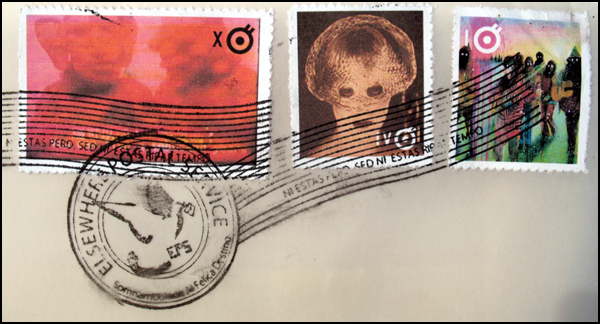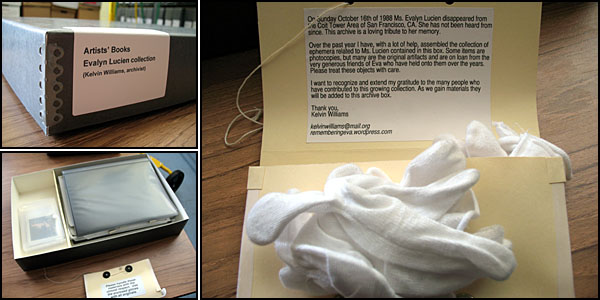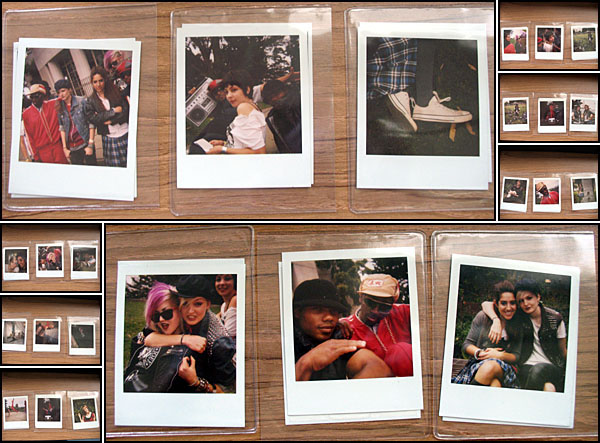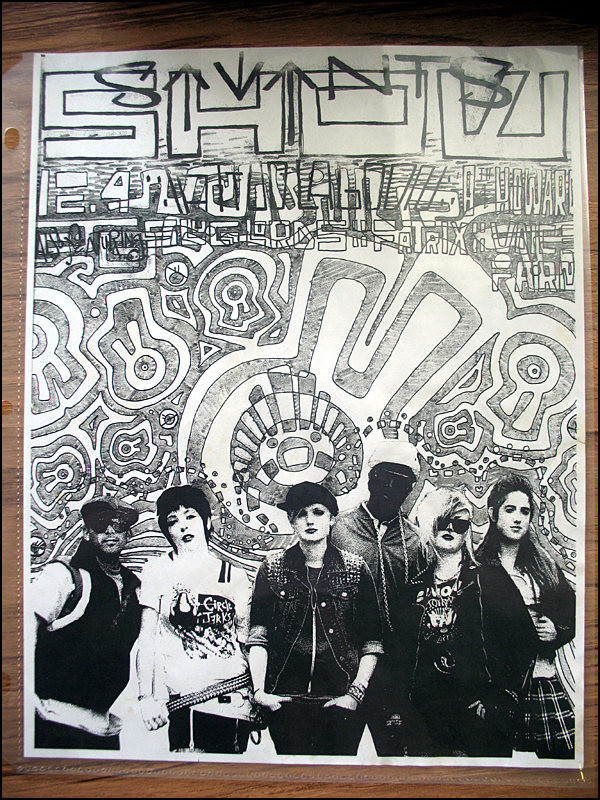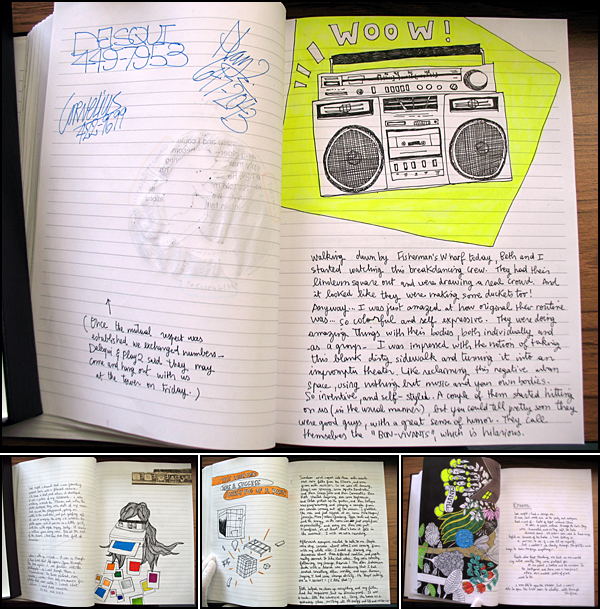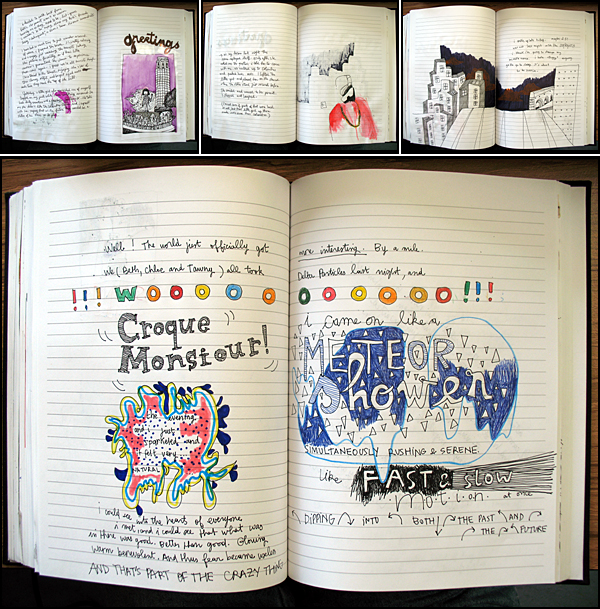Things have been changing. The Whole Bohemian line-up shifted a little bit, adding and subtracting.
The TIMECRAFT 13 ANCHOR disappeared for awhile, being replaced by a small instructive card on a string. Then, mysteriously, weeks later, the ring returned. The elevator plaque vanished. Eddy had been 86’d from the walkthrough, drastically reducing my chances of getting that complimentary chow mein. The creators started opening up a little bit; this interview with Jeff Hull from Nonchalance was one of the first times most people involved in this construct had heard from anyone behind the curtain:
[...] I feel that this real world element of ARGs is kind of where the future of entertainment media is going, not just in the ARG field but really entertainment media. It shouldn’t just take place on the screen or online, but having these type of multimedia immersive narrative experiences. It’s not just entertainment, but it’s communication and education.
So, it’s a different way to interact with each other. It’s a different way to interact with space. The opportunities to produce these types of games, we’re hoping there are going to be more and more of them but, also, for individuals to create these type of narrative experiences for other people.
So far, one of my favorite narrative experiences had been one that I heard about secondhand from Duckstabd:
So, I figured I’d take my kids on episode two, after they enjoyed episode one. I ran episode two the first time with someone else, but didn’t get the artifacts (because I didn’t want to give up my hobo coins, when I knew the “fam” was doing it with me the next day). We ran the content, wrapped it up. BIG hit, so much so that Thomas (then age 3.8) couldn’t get enough of the worlds smallest letter (he has an obsession with small things). He was kind of freaking out at having to put it in the little baggie that we were putting our “artifacts” in, so Katherine decided he should be allowed to have it while in the car, because, hey, where could it possibly go. Sadly, back home, he doesn’t have it anymore, and doesn’t really respond to inquiries as to where it’s gone. We took everything out of the car, kids car seats, real car seats, the cushions, I mean everything. We were nearly down to the frame looking for it. Bupkis. Thomas comes up and asks, “what are you guys looking for?”, then I explained about the missing letter, and if he knew where it was (again). This time, he points to his stomach and says “In here.” He ate it. Sure, that makes perfect sense. He’s a real consumer of the content. Of course, this makes for some bad times trying to get through the loops on the EPWA website; but fortunately for me, Everfalling (hero) had posted detailed photos of the letter, so I could still “win”. Points for the internet, and for human digestion.
While puttering around the middling states, I sent Nonchalance a pair of stamp scissors so they could, theoretically, make nice edging on their stamps. A long, long time ago, a friend told me about a friend of his who was able to create perfect perforated edges on art stamps but refused to tell him how she did it. When he unlocked the secret, he was kind enough to tell me, though maybe she went whole hog with one of those stamp perforating machines instead of the low-rent scissors route. I can’t remember if I signed the note, I was all caught up in the road trip experience. In an ideal world, I would just do this continually. Get away from everything, forever.
Oakland Iowa is different than Oakland California in every way you can think of. Months later, I found out that the edges the scissors cuts are too big for regular stamps. If you were making a four inch, five inch stamp, sure. What kind of world needs five-inch stamps? Such a crazy notion!
Around then, it seemed like a good time to make stickers for the augmentation of personal items: portable music devices, drinking glasses, wheelbarrows, etc.
And who wouldn’t love smaller versions of the microwave harassment sticker – it’s Microwave Harassment Jr. Easier to palm, easier to apply to your own personal belongings. Adorn bookbags, sprinkler cans, pedal karts, what-have-you ... in mere seconds.
This is the Goldwell Open Air Museum in Rhyolite, Nevada. When I first saw the Corporate Goddesses of 580 California, I thought they might have been created by the same artist, but these were made by Albert Szukalski around the same time.
Kelvin was also updating his weblog now and then, but then his postings took a dramatic uptick. His quest for knowledge lead him to Cornelius (from Hip Hop Shoe Repair) who handed him three school essays Eva had written.
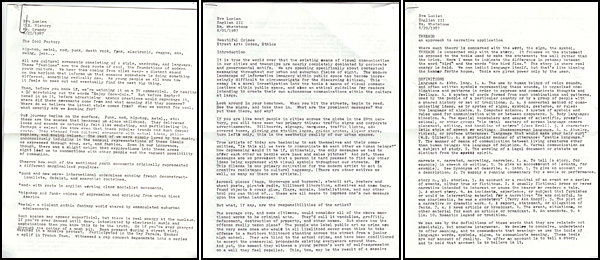
The first, “The Cool Factory,” details the co-opting of genuine sub-cultural movements by The Corporate Machine.
[...] And when refocused, this energy becomes a critical societal factor, the fuel behind actual social and political movements. This core energy I have dubbed “Pop Essence.” [...] Our task is to harness the Pop Essence without diluting its underlying energy.
The second, “Beautiful Crimes,” is an overview of street art and its place in the continual blinding smear of corporate boosterism.
Aerosol pieces (tags, throw-ups and burners), stencil art, posters and wheat paste, pirate radio, billboard liberation, adhesives and name tags, found objects & crazy glue, flags, murals, installations, and any other tool you can think of... these are all means to impress one’s own message upon the urban landscape.
It continues into a request for equivalency – if giant corporations can litter the streets with unavoidable advertisements, where is room for the public? For artists?
This argument is not simply an esthetic or legal one; it is political, sociological, ideological, and ethical. Consider this; for any significant movement to take hold in the culture at large there needs to be room for open communication, as well as a fair exchange of information. How can any such movement take place in the populace if the means for open communication are totally dominated by commercial interests? Currently, there is a veritable corporate lock on public modes of information exchange, practically insuring a stasis in the social and political order.
The paper wraps up with a “list of ethical considerations” for the burgeoning street artist.
[...] If your work is good and finds resonance with an audience, you will gain acceptance and respect as an artist, which are generally rather dubious achievements. There are benefits, however: eventually doors will open for you to create artwork in permitted contexts and ideas may be exchanged as a result of your art. Ultimately, you will have played a minute role in loosening the social controls that currently restrict the use of public spaces. It will be a slow and tedious process, but such is our path.
Eva’s English teacher, a “Ms. Whetstone,” gave the paper a D+, asking: “please enlighten me – what does any of this have to do with Hamlet?”
The final paper, “Threads,” is a five-page consideration of the scope of narratives in society and Eva’s desire to reduce the “hyperreality” of the mass media down to something more personal, tangible, and relatable.
I would like to suggest now that if we as a culture began to change our focus from TOP STORIES to BOTTOM STORIES, that somehow the power and influences that dominant stories have over us would also diminish. Imagine if we suddenly switched our heroes from The Superman to The Bus Driver?
Kelvin had also met up with Beth who was slowly releasing items to him – photos, postcards – and then she gave him Eva’s journal. He made all of these things available to interested parties by placing the bundle directly in the care of the Prelinger Library, an “appropriation-friendly, image-rich, experimental research library. Independent and open to the public.” You can also access over 2000 ephemeral films online at the Prelinger Archives.
As a whole, the collection currently contains over 10% of the total production of ephemeral films between 1927 and 1987, and it may be the most complete and varied collection in existence of films from these poorly preserved genres.
So we went to the Prelinger Library. We’re not SAPS.
The box contained Polaroid photos, postcards, essays, flyers, and the suprisingly large journal. I had just come from a research trip to the other side of the country, where I was required to wear white gloves while handling sensitive materials in two different archives. So I had this glove thing down. A cinch.
The photos of Eva with the nascent SF Savants messing around at Coit Tower left one question in my mind. Is Polaroid stock still available? [FX: looks] An online retailer is selling three ten packs for $150.00. So yes but ouch.
The flyers were for the SF Savants appearances at Tattoo Lagoon and other now-defunct SF clubs.
The postcards are from Beth to Eva, complaining of her overly-regimented vacation with her parents (a later investigation of Eva’s address led to a wonderful view just shy of Coit Tower). That left the journal, which had a heft to it – 292 pages filled with thoughts, drawings, collages, stories, added to until Eva’s disappearance in October of 1988. One of the first few pages had a bit of brown paper pasted on it which was used to play a quick game of Exquisite Corpse, a phrase or image building game created by the Surrealists in which each successive person only sees a portion of the previous person’s creation, onto which they build on.
[...] Go through the door. Service elevators and employees entrances? Then become an
employee for a moment.
These obstacles are imaginary. Walk right through them.
It will lead you to the top of skyscrapers. [...]
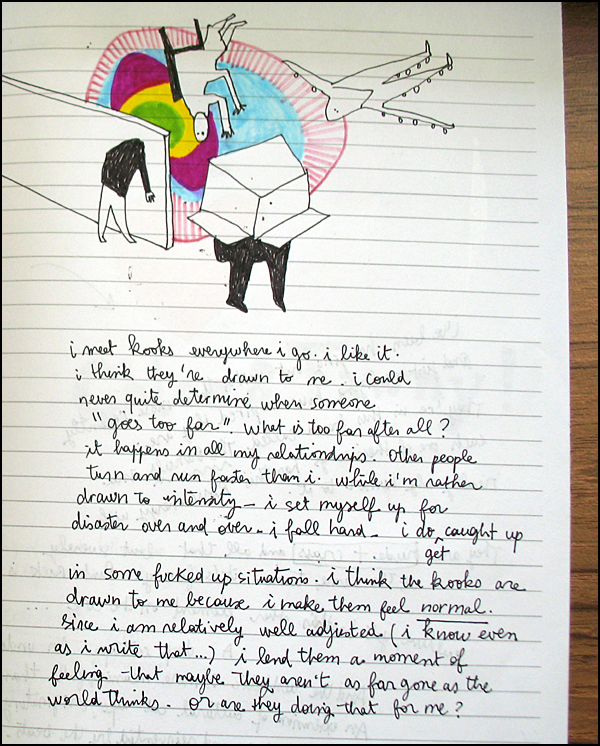
Eva talked about her father, “a genius by anyone’s account. Lost in numbers [...] i’ve never in my life heard him use the phrase ‘i feel.’ Does he feel? i’m a bad daughter [...] it’s just hard to relate to him. i am attracted to that which is emotionally challenging; i know this about myself. Emotionality is where i dwell [...]”
Fragments of French occasionally made appearances. Eva talked about being interested in lucid dreaming. She met Chloe & Tawny: “They are rude & crass and all that but severely intelligent and hilarious at the same time [...]” The loss of her mother: “[My father] told me the world was safe ... or at least that i had a safe place in it. It’s difficult to compute when people just vanish. How am i to maintain my faith and expectations when my mother is fucking gone –”
Eva’s father had her go to a shrink, Dr. Jane Hewitt. “She understood my situation, and she seems like ... it may actually be nice to talk to her about how strange things have been lately. I think i should feel her out a bit more, but she seems ... different.”
Eva met a breakdancing crew; Delsqui, Trey, and Cornelius. She reproduced a Joan Miró artwork in her journal, with a caption added: “Earning international acclaim his work has been interpreted as surrealism, a sandbox for the subconscious mind, a re-creation of the childlike ...” “Surrealism” is circled. Memories of her mother described to Jane Hewitt: “[...] she’d show me how to meditate while smelling all the different flowers ...” While her father is away, Eva hosts a party which leads to the forming of the SF Savants:
“[...] Play2 was spinning some Afrika Bambatta [sic] and then Graces Jones [sic] and then Dominatrix. Then Beth started layering over some keyboards, and Chloe picked up the guitar, and then Delsqui was programming and playing a sampler from our sounds coming out of the mixer. I grabbed the mic and just ripped it on some Nina Hagen / Jennifer Miro / Allen Ginsberg type rants and raves and the energy in the room just amplified exponentially and every one there was just transfixed, or at least that’s how it felt in the moment [...]”
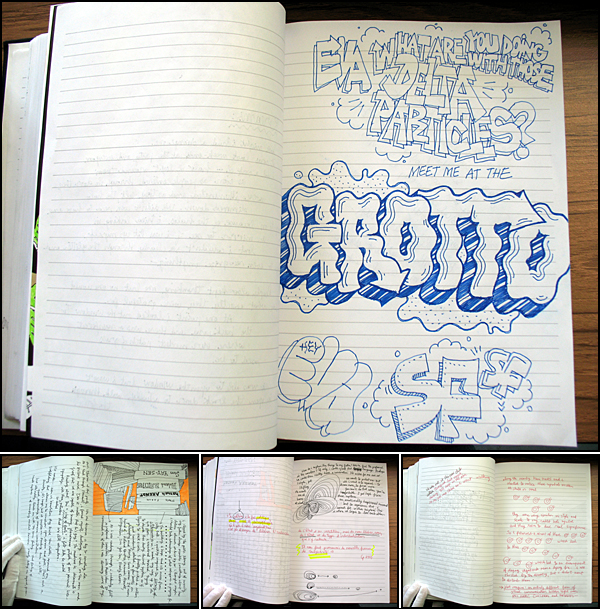
Eva noticed strange symbols around Coit Tower: “I call it the rabbit hole – I’m noticing it around more and more –” She also started hoovering up philosophy books at the library: “Roland Barthes, Hannah Arendt, Wittgenstein, Sun Yat-Sen, Frantz Fanon.” Foucault became a favorite: “Reading him is still, quiet, demanding of immense concentration ... but ultimately leaves me with the same feeling. That feeling of ... small ruptures ... of crumbling mental barriers. Slowly letting me expand, grow.” She included a French passage from Foucault’s essay Why Study Power: The Question of the Subject:
Maybe the target nowadays is not to discover what we are, but to refuse what we are. We have to imagine and to build up what we could be to get rid of this kind of political “double bind,” which is the simultaneous individualization and totalization of modern power structures. The conclusion would be that the political, ethical, social, philosophical problem of our days is not to try to liberate the individual from the state, and from the state’s institutions, but to liberate us both from the state and from the type of individualization which is linked to the state. We have to promote new forms of subjectivity through the refusal of this kind of individuality which has been imposed on us for several centuries.
A few pages later, Eva described her meditation sessions with her mother: “I meet my mother in my dreams. At times I think it’s all in my head. Other times I think that it’s absolutely real, that she’s finding ways to take care of me still [...] I’d discover a door in the side of the garage that wasn’t there in real life. It would open at my touch. Down again into an ancient subterranean room with rectangular pools of water that just left two feet of space to walk on all sides [...] From there a door would appear to another realm we called Elsewhere. Which is ... impossible to describe visually – I can only talk about the warm feeling ... like I’d taken up a residency inside God’s heart of hearts.”
Eva then discovered more rabbit holes leading to “an encampment of sleeping vagabonds near a dying fire [...] Just imagine: an entirely different form of visual communication hidden right under our noses! Curiouser and curiouser –” She then went to the library and discovers that the rabbit hole is a “hobo glyph.” During Eva’s visit to Dr. Hewitt she used representative dolls to unlock subconscious thoughts. Practiced regularly with her band. Continued her exploration of surrealism, wrote down excerpts.
“It is living and ceasing to live which are imaginary solutions. Existence is elsewhere.” – André Breton (Surrealist Manifesto)
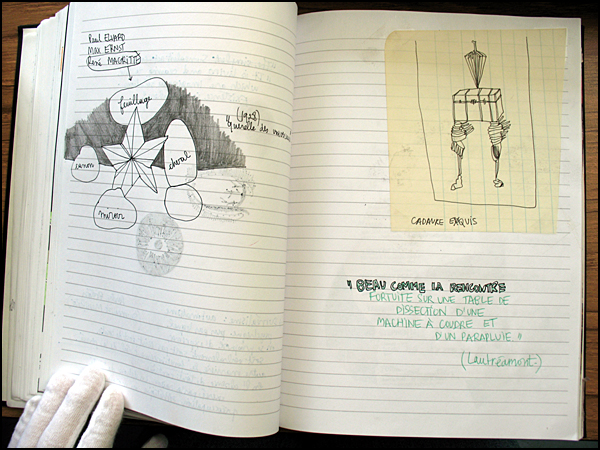
“Beau comme la rencontre fortuite sur une table de dissection d’une machine à coudre et d’un parapluie.” – Comte de Lautréamont
This quote, “beautiful as the chance meeting on a dissecting table of a sewing machine and an umbrella,” was used by Breton and other surrealists as an example of surrealist dislocation. After reading Lautréamont’s book, Les Chants de Maldoror, they referred to him as a “prophet.”
But “Comte de Lautréamont” was a pseudonym. His real name was Isidore Lucien Ducasse. Lucien. I had thought that “Eva Lucien” was just a homonym for “evolution.” Some time after this, Duckstabd recommended the 1983 hip hop documentary Style Wars which devotes a large section to graffiti artists. One artist recounted various early adopters:
“ ... Stitch came out around 1971 ... Barbara and Eva 62, they were girls ...”
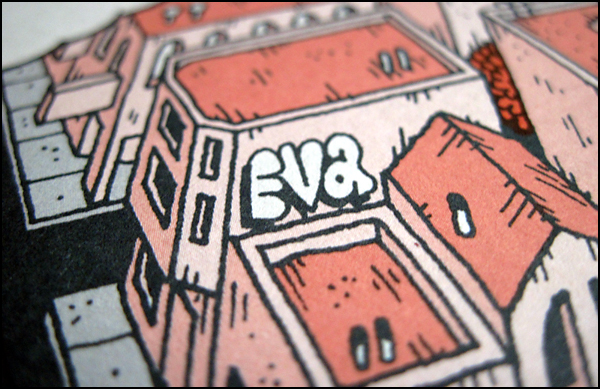
Further research indicated that the first women taggers are believed to be Barbara 62, Eva 62, and Michelle 62, the “three graces” (Graces Jones?). Then I ran into a wall.
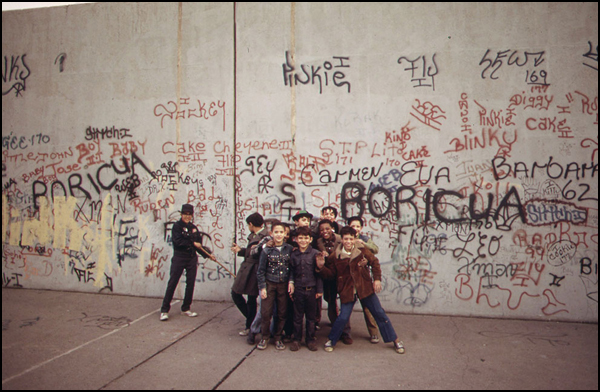 Bronx 1973 (Dan McCoy / NARA)
Bronx 1973 (Dan McCoy / NARA)
“When I took this picture in Riverside park [in 1990] they had finally painted the handball court’s wall. It had been covered with vintage graffiti by the local legends Barbara & Eva 62 who I’m guessing came from the Amsterdam projects just a few blocks away.” – Matt Weber
Numbers in a name for early taggers usually demarcated a street number; the Amsterdam projects hang off of 62nd Street in Manhattan.
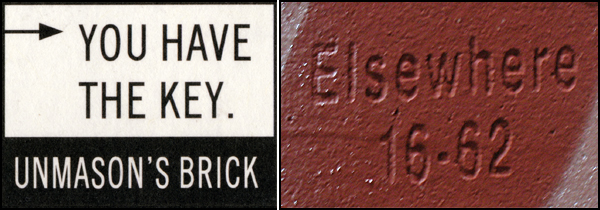
Eva 62, Barbara 62 and Michelle 62 seem to have been lost to history. Or perhaps my search-fu is too weak. So. Eva-Lucien : Graffiti-Surrealism.
Back in the journal, Eva detailed her high school PA prank, inspired by a child she witnessed making random barking noises. “i’ve been studying the surrealists lately. It made me wonder if i should be painting more. But i don’t want to do it on canvas, i want to do it on the world.” She mentioned finding a small silver charm from her mother that had a short quote from Rumi on it and this brought up mixed feelings about her mother. A different Rumi quote:
In China they tell of three laughing Taoist masters, who taught by going into town and standing in the marketplace and laughing. One of them died. People curious as to how the remaining two would act gathered at the funeral pyre. The other two masters had been given instructions not to prepare the body in any way, not even to change the clothes the dead man was wearing. He had crammed his pockets full of firecrackers. The teaching began again. Rumi’s poems are like firecrackers on a funeral pyre. They won’t allow much public posturing, and they point us away from misery.
– The Essential Rumi Translations by Coleman Barks with John Moyne [pg 238]
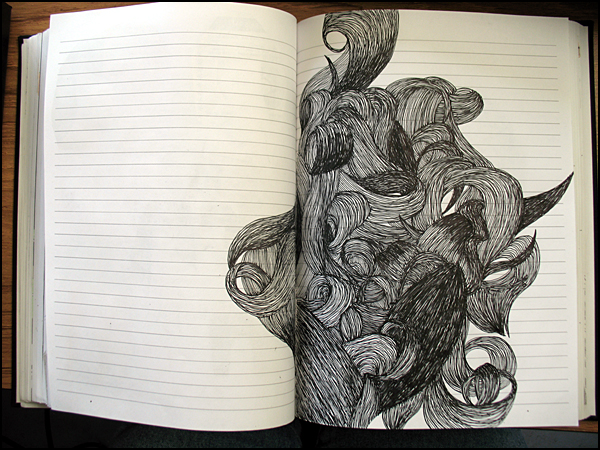
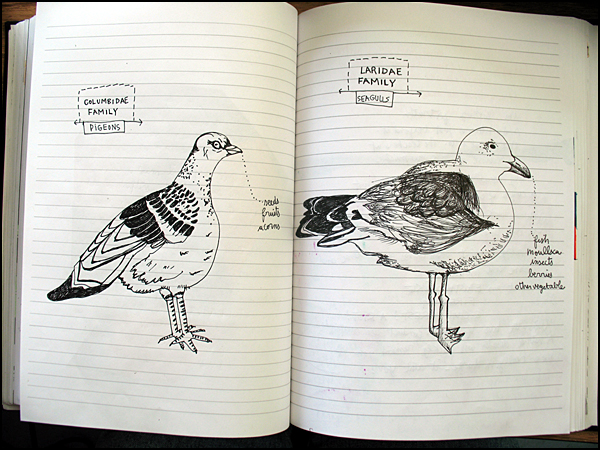
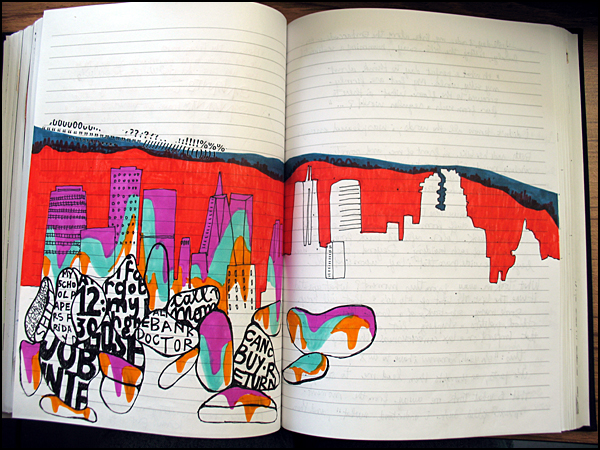
A number of entries detail the preparation that went into her birdseed-football prank – acquiring the four football jerseys, feeding the birds. It goes off without a hitch.
“i’m kind of getting addicted to this. It feels like it’s the one primary way i can be effective in this world. Each act is a reminder for people to think and rethink. It has real value.”
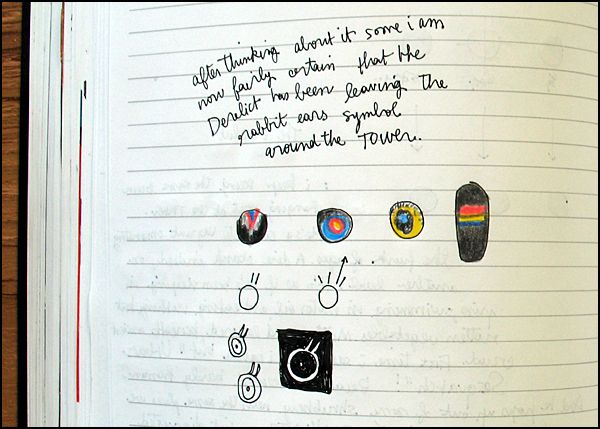
Dr. Hewitt told Eva about a memory recorder in the testing phase. Eva began to have sporadic “weird pulsing” headaches. The Savants broke into the high school and posted a large amount of spurious flyers designed to look official; Eva was expelled. “[My father] said i should feel fortunate that Principal Moore didn’t pursue criminal charges against me for slander [...] Now Galileo is going to have to live without my sauce!”
San Francisco’s head librarian, Gladys Hansen, took a shine to Eva and “indulges my whimsical investigations.” Fall approaches; Beth is continuing at Gallileo, other Savants are moving onto college. “Maybe i’ll start junior college next year or something. In the mean time i’m continuing on my own self directed course of study & practice: ’CREATIVE THEORY & APPLICATION.’”
Eva met the derelict, Neil. “He came right up to my face and began to speak, saying he knew my mother, that he had been sent from another place, that i was the ‘Queen of a Lost Tribe.’ He said that the time is coming when obstacles will be obsolete [...] And where would we be without these obstacles? Neil said ... ‘Elsewhere.’ At the time i was so high that i didn’t think twice about it. Of course this complete stranger knew the name of the secret fantasy place i inhabited with my mother as a child! Sure – this makes perfect sense to me. – But now, under light of day, i admit i am terrified. –”
She went to a “memory rendering session” on Dr. Hewitt’s recommendation. “I should be able to see the tape next week. What does the inside of my head look like exactly?” Some time later, a dramatic change overcame Eva:
Amazingly lucid today. Beyond 20/20 vision, whatever that looks like. i can see molecules and subparticles floating in the air, the cells in your skin undergoing mitosis. i can hear the worms beneath the Earth, and the colonies of ants in the oak trees as i saunter by. i’m simultaneously honing in on the distant hum of irregular galaxies drifting just beyond our perceptions. it is the sound of tranquility. and calm.
while my entire world seems to crumble around me, i feel calmer than ever. i can see the
panic in the eyes of my loved ones as they witness this change in me [...] i am off to play in a place they will not be able to follow [...] Excitement? not exactly ... it is a calmness. a knowing [...]
A page or two later, the journal itself had transformed as well.
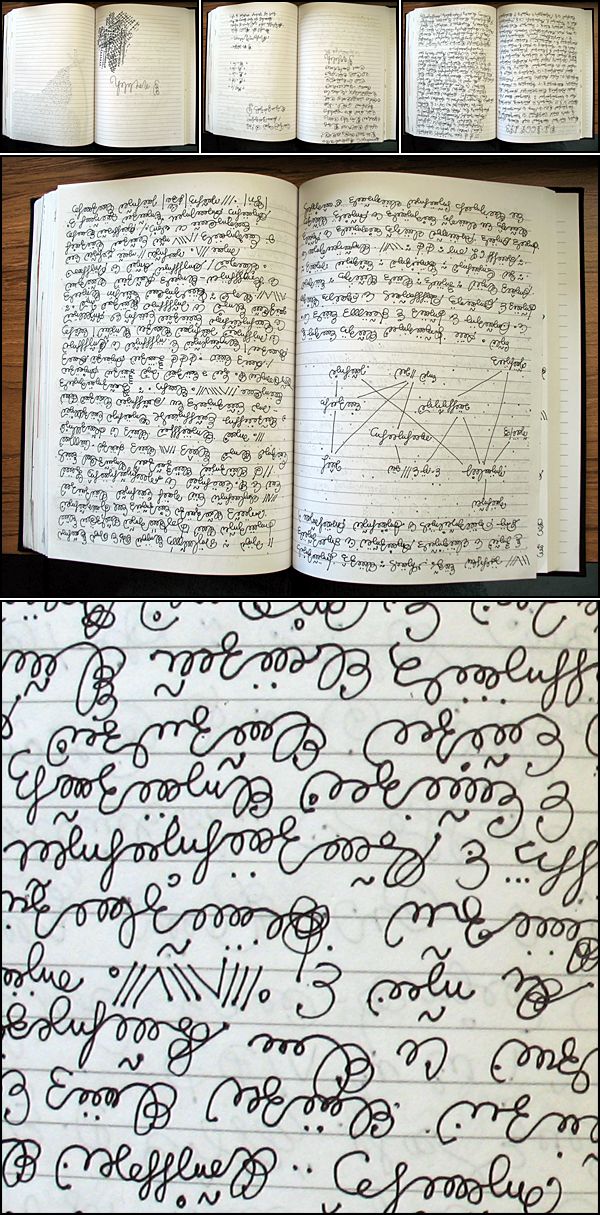
Sixteen pages of cryptic writing. The rest of the journal was blank.
Say, why not continue on to the next part: Reconstruction.




